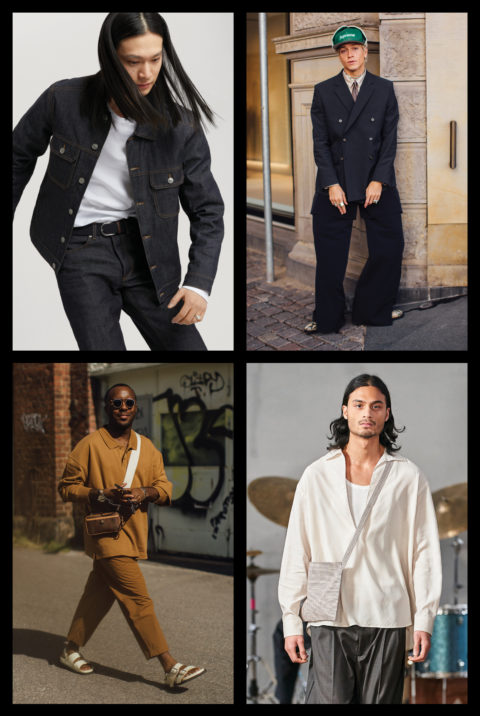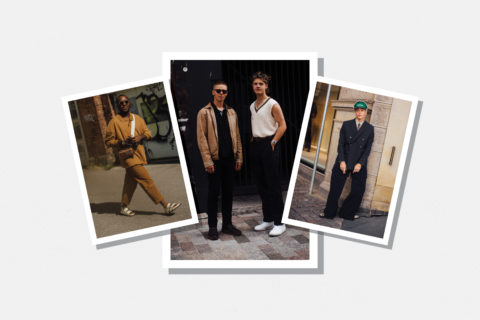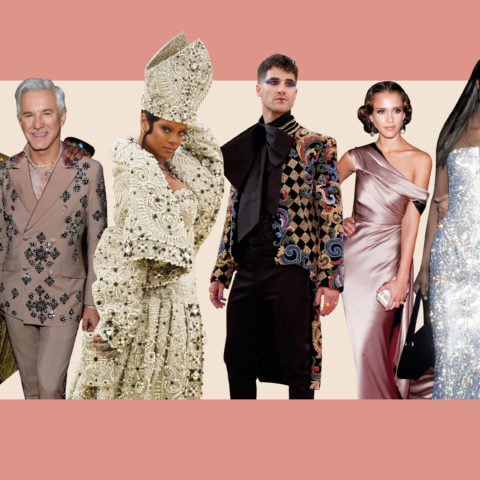When It Comes to Fashion, Scandi Boys Know What They’re Doing
Scandi girls were first to gain street-style cred, but it’s Scandi boys who should be your next sustainable-style inspo.
Ten years ago, flush with the money I had saved from my first real job, I tentatively wandered into Jonathan + Olivia, a cutting-edge boutique on Toronto’s Ossington strip that, tragically, closed in 2018. It was having one of its legendary sales, and I scoured the racks in search of an affordable designer piece that would, I hoped, accelerate my metamorphosis into a stylish, sophisticated person and stumbled upon a raglan-sleeved crewneck sweatshirt in a grey mélange. It was weightier and cut boxier than the threadbare sweatshirts of my youth — an elevated essential layer I could wear casually or dress up. I checked the tag to see who had made this exceptional garment and discovered a men’s label I had never heard of before: Our Legacy.
Today, Our Legacy remains at the forefront of Scandinavian menswear, exporting its vision of quirkily layered cool to in-the-know guys around the world, along with the brand Mfpen from Denmark and Another Aspect and Asket from Sweden. These labels project an attitude about dressing that emphasizes individuality and wearability with a sustainable ethos. Some, like Mfpen and Our Legacy, use dead-stock fabrics or digital printing techniques to save water and minimize waste. Others, like Asket and Another Aspect, promote a “buy less, buy better” ethos to encourage acquiring only what you need and nothing else.
Let’s call the men who embody these sartorial values “Scandi boys.” Unlike Scandi girls, who seem to dress in extremes (super minimalist or Ganni-fied and garish), Scandi boys have a style that resembles elevated norm-core — according to local designers and stylists and a scan of street-style photos from the recent Copenhagen Fashion Week. Think clean shapes, muted tones and at-first-glance unassuming fits amped up with freaky-functional layering and subtle gender blurring. But the devil is in the details: an uncluttered closet that’s heavy on sustainably made everyday staples mixed with second-hand grails. So, what style lessons can we all learn from them?

In the early aughts, Scandi brands Acne Studios and Filippa K became the de facto uniform for fashion insiders (and wannabe insiders) because of their raw denim, white sneakers and merino-wool sweaters. The fashion press later labelled the emerging trend “Scandinavian minimalism” — a term that still sticks. It doesn’t so much capture a style as a mentality that informs design, style and consumption. “Scandinavian fashion comes from this element of practicality and comfort,” says Sarah Arts, the head of brand marketing and communications at Asket. “That doesn’t have to mean you neglect style or aesthetic. But I think if you really look at all Scandinavian brands, from interior to fashion, there is that element of clean shapes, practicality and warmth.”
Some of today’s Scandi boys gravitate toward more classic clothes, according to Nicole Walker, a Swedish stylist who has worked with über-cool brands including Our Legacy. But they’re experimenting with silhouette and gender within the confines of traditional menswear. She also feels there are differences within Scandi style. The Danes, she muses, see themselves as “super ultra-expressive” whereas the Swedes hew toward minimalism. “The menswear scene in Stockholm is really evolving, maybe even more than the womenswear, because of this idea of mixing new and old pieces and really finding personal expression,” says Walker, extolling the resale market for fuelling this sense of discovery and restyling existing clothes in novel ways.
@secondhandhuns One for the men 💅🏻 #whatpeoplearewearing #streetstyle #streetfashion #ootd #mensfashion #springoutfit #scandinavianstyle #stockholmstil #menstyle #scandistyle #outfitspotting #stockholm #swedishstyle
Asket represents a modern version of Scandinavian minimalism. Jakob Dworsky and August Bard Bringéus launched the label in 2015 with a T-shirt and have been building a permanent collection of about 50 “zero compromise garments,” or timeless, ethically made wardrobe essentials, including Oxford shirts, great-fitting denim and chore coats that “men will count on 99 out of 100 days,” says Arts. “What’s really important is to acknowledge that the apparel industry is fundamentally flawed,” she says. “It’s about tackling this cycle of overproduction and overconsumption and really getting people to reconnect with their clothes, to think about what they really need.” (For Arts, these values reflect the Swedish concept of lagom, which translates to “just enough.”) Asket reinforces that commitment through its retail strategy. The brand operates a Stockholm flagship and another store selling samples, returns and second-hand items.
Daniel Brøndt, co-founder of Another Aspect, a small Swedish menswear brand, champions a similar spirit. “We don’t think people need 10 pairs of jeans,” he says. “We think they need maybe two or three really good pairs that they can keep for a very long time.” Another Aspect releases two collections a year of sustainable hard-working staples with just enough direction to catch the eye of a customer looking for classic pieces with a contemporary twist. The brand’s organic-cotton relaxed button-ups and straight-fit denim are sold at specialty boutiques like Voo Store in Berlin and made an appearance at a pop-up at Colbo in New York last year. It’s the right time for Brøndt’s brand to shine: Scandinavian guys are returning to a classic wardrobe after recovering from logomania, he says. The truth is that there is no singular Scandi-boy style, no unified aesthetic. But the growth of sustainably minded brands and the resale market have blasted the door open to uncharted fashion universes. A little lagom goes a long way. And for what it’s worth, I wore that Our Legacy sweatshirt for years, until it shrank into a crop top.
This article first appeared in FASHION’s April 2024 issue. Find out more here.








